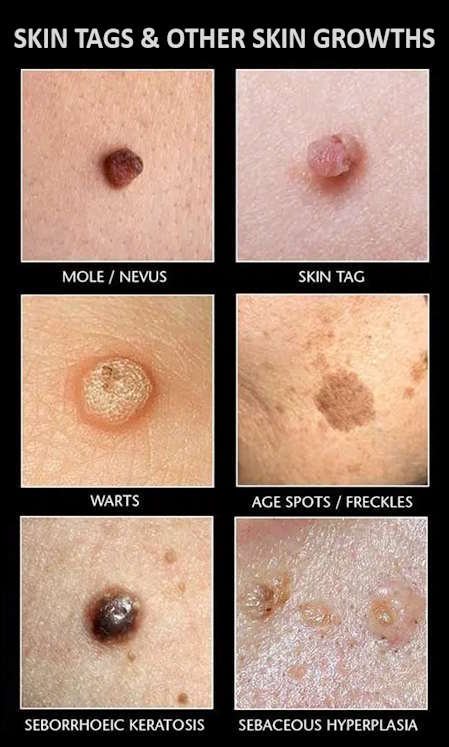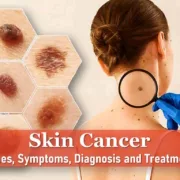What are Skin Tags and Everything About Skin Tag Removal
What is a Skin Tag?
Skin tags are one of the most common skin growths seen in adults. They are benign, flesh-colored growths that often resemble small, soft balloons hanging from a thin stalk. These growths may be the same color as your skin, darker, or even pink. They can also turn red when irritated. Though harmless, they can be numerous and may appear anywhere on the body. Skin tags are as common in men as they are in women, and there is a notable correlation between obesity and the development of skin tags. While some may fall off naturally, most skin tags persist once they form. Despite their variations in appearance, many people share a common desire to remove these growths. Here, we explain how dermatologists remove skin tags and address other frequently asked questions from patients.
Do Skin Tags Get Bigger?
Skin tags can grow, but they usually do not increase significantly in size over time. They are composed of excess skin and sometimes collagen fibers, which is a type of protein. Factors such as friction, irritation, and individual biology can affect their growth rate and extent. Initially, skin tags may be as small as a flattened pinhead-sized bump, typically between 2 mm and 5 mm in diameter. However, some can grow as large as a big grape (about 1 cm in diameter) or even a fig (about 5 cm in diameter). Not all skin tags enlarge, and many remain the same size throughout a person’s life. If a skin tag changes significantly in size, color, or starts to bleed, it is important to consult a healthcare professional.
What Causes Skin Tags?
The precise cause of skin tags is unknown, but several factors are believed to contribute to their development
- Friction and Rubbing Skin tags often develop in areas where skin rubs against skin, jewelry, or clothing. Common sites include neck creases, armpits, the groin, and under the breasts.
- Skin Irritation and Inflammation Chronic skin irritation or inflammation from conditions like dermatitis may increase the risk of developing skin tags.
- Insulin Resistance and Obesity There is a significant correlation between high body mass index (BMI) and skin tags. Insulin resistance and high insulin levels can promote skin cell growth, contributing to skin tags.
- Hormonal Changes Hormonal fluctuations, especially during puberty, menstruation, pregnancy, and menopause, can affect skin elasticity and collagen production, leading to skin tags.
- Genetics A family history of skin tags increases the likelihood of developing them.
- Age Skin tags are more common in middle-aged and elderly individuals due to decreased collagen and elastin production in the skin.
- Growth Hormone Disorders Conditions like acromegaly, which increase insulin-like growth factor 1 (IGF-1), can lead to skin tags.
- Sun Exposure Ultraviolet (UV) radiation can damage skin cells, potentially leading to skin tags.
Common Locations for Skin Tags
Skin tags can appear anywhere on the body, but they are most common in areas prone to friction, such as
- The base of the neck
- Underarms
- Eyelids
- Groin folds
- Buttock folds
- Under the breasts
Vaginal Skin Tags and Genital Skin Tags
While skin tags are uncommon on moist surfaces like the vagina, they can sometimes occur on the external genitalia such as the labia majora and labia minora. In such cases, it is essential to rule out other conditions like genital warts through a tissue biopsy. Skin tags can also appear on the penis and scrotum, and a biopsy may be needed to differentiate them from genital warts caused by the human papillomavirus (HPV).
Who Tends to Get Skin Tags?
More than half of the general population will develop skin tags at some point in their lives. They are more common in middle-aged individuals but can also appear in children, particularly in the underarm and neck areas. Pregnant women and individuals with obesity are more likely to develop skin tags due to hormonal changes and insulin resistance.
Are Skin Tags Tumors?
Skin tags are a type of benign tumor, meaning they are non-cancerous and do not become cancerous if left untreated. However, in extremely rare cases, a skin tag may become precancerous or cancerous. Skin tags that bleed, grow, or change color should be evaluated by a healthcare professional to rule out other conditions, including skin cancer.
Symptoms of Skin Tags
Skin tags generally cause no physical pain or discomfort, except when they are irritated by friction from clothing or jewelry. Cosmetic concerns are the most common reason for skin tag removal. Symptoms that may necessitate removal include
- Irritation and redness
- Bleeding or blackening due to twisting
- Snagging on clothing or jewelry, causing pain or discomfort

Conditions That Mimic Skin Tags
While skin tags are usually distinctive, other skin growths can look similar, including moles, warts, seborrheic keratoses (skin barnacles), and neurofibromas. Groin and genital lesions resembling skin tags may be genital warts, which require a biopsy for accurate diagnosis. Rarely, basal cell carcinoma, squamous cell carcinoma, or malignant melanoma can mimic skin tags.
Medical Procedures for Skin Tag Removal
Skin tags are generally harmless, but some people choose to have them removed if they cause irritation or for cosmetic reasons. It’s important to have skin tags removed by a board-certified dermatologist to ensure the procedure is safe and effective.
There are several medical procedures that healthcare professionals use to remove skin tags:
Cauterization
Cauterization involves burning the skin tag off using a heated tool or a small electrical current. The heat destroys the tissue, causing the skin tag to fall off. This procedure is relatively quick and may cause minor discomfort. However, there’s a risk of scarring or infection if not done properly. Cauterization is typically performed by dermatologists or other trained healthcare professionals.
Cryosurgery
Cryosurgery, also known as cryotherapy, involves freezing the skin tag using liquid nitrogen or another freezing agent. The extreme cold destroys the cells in the skin tag, leading to its eventual removal. Cryosurgery is a common and effective method for removing skin tags. It’s relatively quick and usually well-tolerated, although there may be some discomfort during the procedure. Temporary redness or blistering of the skin is common afterward.
Ligation
Ligation, also known as tying off, involves cutting off the blood supply to the skin tag by tying it tightly at the base with a piece of surgical thread or dental floss. This causes the skin tag to eventually wither and fall off. Ligation is a simple and relatively painless procedure that can often be done in a doctor’s office. However, it may take several days or even weeks for the skin tag to detach completely.
Excision
Excision involves physically cutting the skin tag off using a sharp tool, such as scissors or a scalpel. Before the procedure, the area is typically numbed with a local anesthetic to minimize discomfort. After the skin tag is removed, the wound is usually closed with stitches or left to heal naturally. Excision is a quick and effective method for removing skin tags, but it may leave a small scar. This procedure is usually performed by dermatologists or other trained healthcare professionals.
Aftercare Tips for Skin Tag Removal
Infections and complications are rare after skin tag removal. However, it’s important to follow proper aftercare to minimize any risk.
- At-Home Removal: If you remove a skin tag at home, apply antibiotic ointment to the affected area and keep it covered with a bandage, just as you would for a cut. This helps reduce the risk of infection. If the area becomes painful or bleeds, see your doctor.
- Medical Procedure Removal: After a medical procedure to remove a skin tag, follow your doctor’s instructions, which may include keeping the wound dry for at least 48 hours and then gently washing the area with soap and water. Your doctor may also schedule a follow-up appointment to check the wound and remove any stitches if they were needed.
Who Can Remove Skin Tags?
Dermatologists are the best professionals to remove skin tags safely and effectively. Primary care physicians, general practitioners, and specially trained nurses may also remove skin tags, but it’s essential to ensure they have the necessary expertise.
Skin Tag Removal Kits and Home Remedies
Over-the-counter (OTC) treatments for skin tags include topical creams and solutions containing salicylic acid or tea tree oil. While these treatments are generally painless and can be applied at home, their effectiveness is not scientifically proven, and they may cause skin irritation. Common home remedies include applying apple cider vinegar, tea tree oil, vitamin E oil, or banana peels to the skin tag. However, these remedies may not work for everyone and can cause allergic reactions.
Are There Medically Approved Creams for Skin Tag Removal?
Currently, there are no medically approved creams specifically for skin tag removal. Unapproved products, such as wart removers or hair removal creams, should be avoided as they can cause irritation and complications.
Will Removing a Skin Tag Cause More to Grow?
There is no evidence that removing a skin tag will cause more to grow. Some individuals are simply more prone to developing skin tags and may experience new growths periodically.
Do Skin Tags Need to Be Biopsied?
Skin tags that bleed, grow, or appear in multiple colors may require a biopsy to rule out other conditions, including skin cancer. While most skin tags are removed without microscopic examination, larger or atypical growths may be sent to a pathologist for further analysis.
Prognosis for Skin Tags
The long-term outlook for individuals who have had skin tags removed is excellent. However, this does not prevent new skin tags from developing.
What Happens When a Skin Tag Turns Purple or Black?
A thrombosed skin tag may change color to purple or black when its blood supply is inadequate. Thrombosed skin tags typically fall off on their own within 3 to 10 days and usually do not require additional treatment. If a skin tag changes color or bleeds, consult a doctor for evaluation.
Should I Worry About Cutting a Skin Tag While Shaving?
No, accidentally shaving off a skin tag is generally harmless. Small skin tags may bleed temporarily and require pressure to stop the bleeding, but infection is rare.
Is It Possible to Prevent Skin Tags?
No, it is not possible to prevent skin tags. However, maintaining a healthy weight and avoiding skin friction may reduce the risk of developing new tags.











